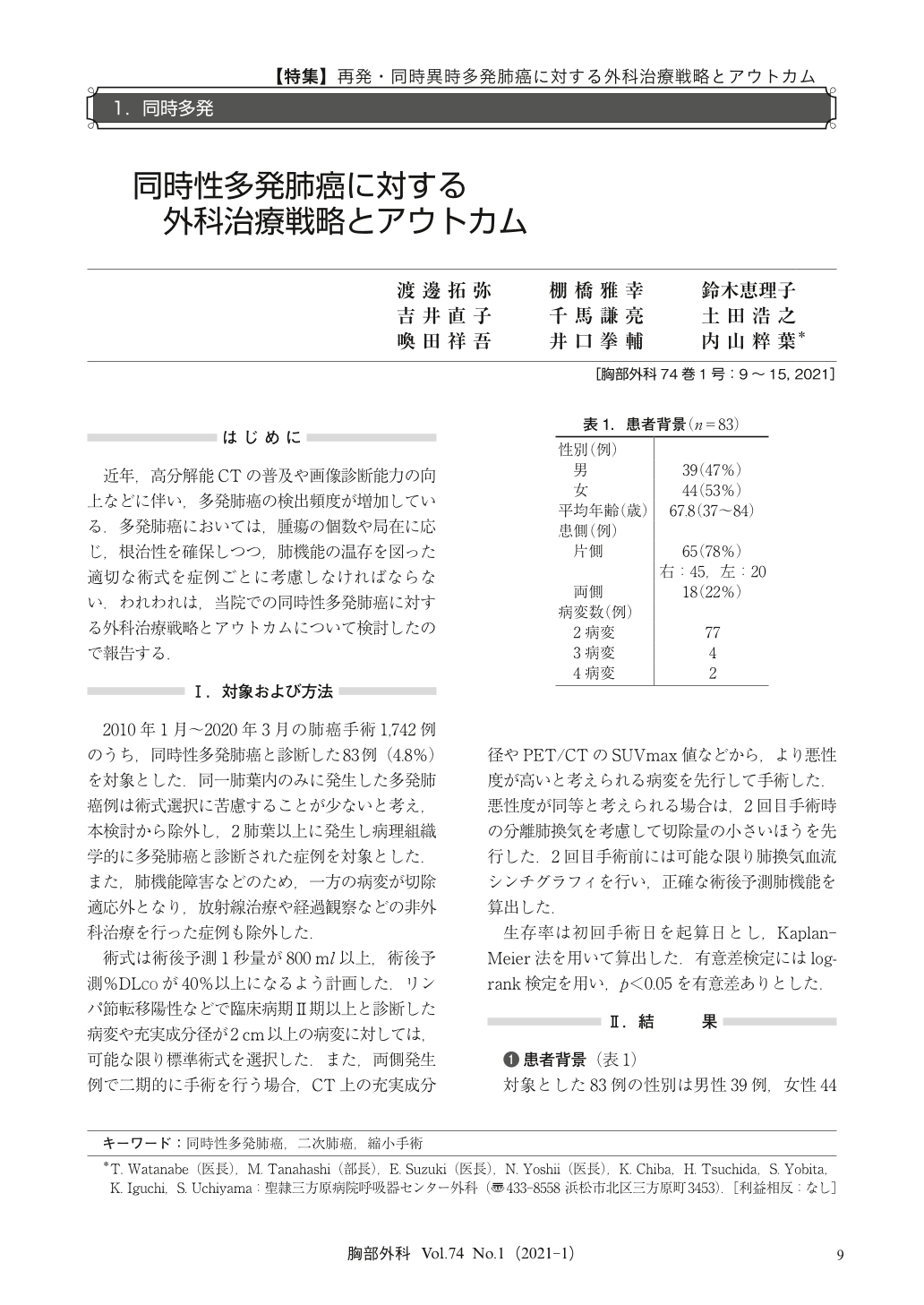Japanese
English
- 有料閲覧
- Abstract 文献概要
- 1ページ目 Look Inside
- 参考文献 Reference
近年,高分解能CTの普及や画像診断能力の向上などに伴い,多発肺癌の検出頻度が増加している.多発肺癌においては,腫瘍の個数や局在に応じ,根治性を確保しつつ,肺機能の温存を図った適切な術式を症例ごとに考慮しなければならない.われわれは,当院での同時性多発肺癌に対する外科治療戦略とアウトカムについて検討したので報告する.
Objectives:With the advent of high-resolution chest imaging systems and lung cancer screening programs, the number of patients diagnosed with multiple primary lung cancers is increasing. For the treatment of multiple lung cancers, a surgical procedure that preserves the lung function while ensuring curability is required. We herein report the surgical strategy and outcomes of synchronous multiple lung cancer.
Subjects:The subjects were 83 patients with synchronous multiple lung cancer who received surgical resection between January 2010 and March 2020. Cases within the same lobe were excluded, and only cases with two or more lobes involved were included in this study.
Results:The study enrolled 39 male and 44 female patients, and the mean age was 67.8 years old. Sixty-five patients had cancers within a unilateral lobe, and all had undergone surgery for one term. Eighteen patients had cancers in bilateral lobes, and 17 of them received secondary surgery for more advanced cancer. Bilobectomy was performed in 9 patients (10.8%), consisting of 5 upper-middle lobectomies, 3 middle-lower lobectomies, and 1 right middle lobectomy with left lower lobectomy. Seventy-four patients (89.2%) underwent combination surgery with sublobar resection, such as segmentectomy and partial resection. Pneumonectomy was not performed in any patients. The histologic type was adenocarcinoma in 78 patients (94.0%), and 37 patients (47.4%) had adenocarcinoma in situ. Regarding the most advanced pathological stage, 57 patients (68.7%) were stage≦Ⅰ, and 26 (31.3%) were stage≧Ⅱ. Postoperative complications were observed in 29 patients (34.9%), and persistent pulmonary fistula of≧7 days after the surgery was the most common, being observed in 16 patients. Operative death within 30 days after surgery occurred in 2 patients (2.4%) [due to pneumonia in 1 and cerebral infarction in 1]. None of the patients required home oxygen therapy after surgery. Recurrence occurred in 20 patients;14 of these had pathological stage≧Ⅱ, 11 had lymph node metastases, and 2 had pleural dissemination. The recurrence patterns were metastasis to other organs, pleural dissemination, or lymph node metastasis;no local recurrence was observed. The mean recurrence-free survival was 32.4 months, and the five-year survival rate was 84.8%. On comparing outcomes according to the most advanced pathological stage, the five-year survival rate for stage≦Ⅰdisease was 94.9%, and that for stage≧Ⅱ disease was 61.7%, showing a significantly better prognosis for stage≦Ⅰdisease (p<0.001).
Conclusions:Selecting an appropriate operative procedure for synchronous multiple lung cancer renders the prognosis equivalent to that of single cancer. Surgical treatments, including sublobar resection, are thus deemed important.

© Nankodo Co., Ltd., 2021


